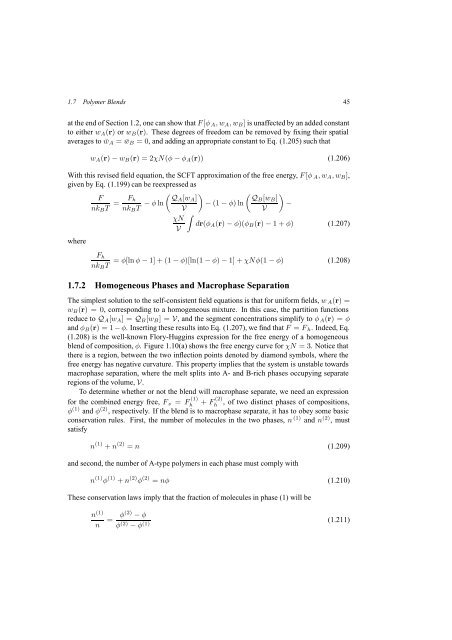Self-Consistent Field Theory and Its Applications by M. W. Matsen
Self-Consistent Field Theory and Its Applications by M. W. Matsen
Self-Consistent Field Theory and Its Applications by M. W. Matsen
You also want an ePaper? Increase the reach of your titles
YUMPU automatically turns print PDFs into web optimized ePapers that Google loves.
1.7 Polymer Blends 45<br />
at the end of Section 1.2, one can show that F [φ A ,w A ,w B ] is unaffected <strong>by</strong> an added constant<br />
to either w A (r) or w B (r). These degrees of freedom can be removed <strong>by</strong> fixing their spatial<br />
averages to ¯w A =¯w B =0, <strong>and</strong> adding an appropriate constant to Eq. (1.205) such that<br />
w A (r) − w B (r) =2χN(φ − φ A (r)) (1.206)<br />
With this revised field equation, the SCFT approximation of the free energy, F [φ A ,w A ,w B ],<br />
given <strong>by</strong> Eq. (1.199) can be reexpressed as<br />
F<br />
nk B T = F ( )<br />
( )<br />
h<br />
nk B T − φ ln QA [w A ]<br />
QB [w B ]<br />
− (1 − φ)ln<br />
−<br />
V<br />
V<br />
∫<br />
χN<br />
dr(φ A (r) − φ)(φ B (r) − 1+φ) (1.207)<br />
V<br />
where<br />
F h<br />
nk B T<br />
= φ[ln φ − 1] + (1 − φ)[ln(1 − φ) − 1] + χNφ(1 − φ) (1.208)<br />
1.7.2 Homogeneous Phases <strong>and</strong> Macrophase Separation<br />
The simplest solution to the self-consistent field equations is that for uniform fields, w A (r) =<br />
w B (r) =0, corresponding to a homogeneous mixture. In this case, the partition functions<br />
reduce to Q A [w A ]=Q B [w B ]=V, <strong>and</strong> the segment concentrations simplify to φ A (r) =φ<br />
<strong>and</strong> φ B (r) =1− φ. Inserting these results into Eq. (1.207), we find that F = F h . Indeed, Eq.<br />
(1.208) is the well-known Flory-Huggins expression for the free energy of a homogeneous<br />
blend of composition, φ. Figure 1.10(a) shows the free energy curve for χN =3. Notice that<br />
there is a region, between the two inflection points denoted <strong>by</strong> diamond symbols, where the<br />
free energy has negative curvature. This property implies that the system is unstable towards<br />
macrophase separation, where the melt splits into A- <strong>and</strong> B-rich phases occupying separate<br />
regions of the volume, V.<br />
To determine whether or not the blend will macrophase separate, we need an expression<br />
for the combined energy free, F s = F (1)<br />
h<br />
+ F (2)<br />
h<br />
, of two distinct phases of compositions,<br />
φ (1) <strong>and</strong> φ (2) , respectively. If the blend is to macrophase separate, it has to obey some basic<br />
conservation rules. First, the number of molecules in the two phases, n (1) <strong>and</strong> n (2) , must<br />
satisfy<br />
n (1) + n (2) = n (1.209)<br />
<strong>and</strong> second, the number of A-type polymers in each phase must comply with<br />
n (1) φ (1) + n (2) φ (2) = nφ (1.210)<br />
These conservation laws imply that the fraction of molecules in phase (1) will be<br />
n (1)<br />
n = φ(2) − φ<br />
φ (2) − φ (1) (1.211)
















